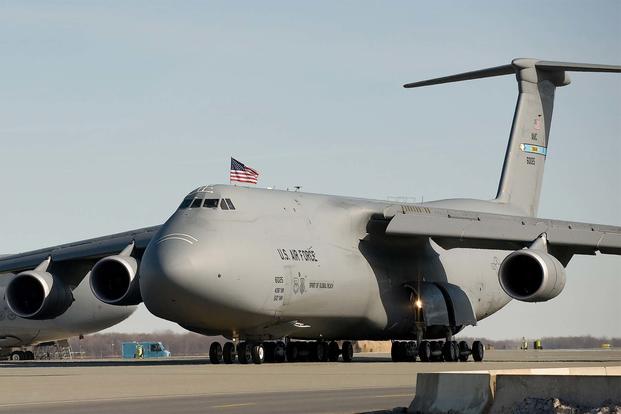C-5M Super Galaxy aircraft remain on stand-down at Dover Air Force Base as maintenance crews and engineers scramble to replace parts, some of which are no longer manufactured, the head of Air Mobility Command recently told Military.com.
"The mechanism is a screw-type mechanism that allows [the nose of the aircraft] to basically spin down and spin back up," Gen. Carlton Everhart II, commander of AMC, said in an interview Wednesday. "What we found out, though, is there's nobody out there manufacturing these anymore."
The service stopped all C-5M operations from the Delaware base July 18 after two aircraft experienced nose-gear malfunctions overseas. Separate incidents involving C-5M aircraft from Dover occurred May 22 and again July 15 at Naval Station Rota, Spain, the command said at the time.
Related content:
- Air Force Halts C-5M Flights from Dover After Nose-Gear Malfunctions
- Super Galaxy Brake Failure Prompts Pre-Takeoff Evacuation in Yokota
- General Warns of Need to Boost Airlift Capacity
- Air Force Wants More C-5s on the Flightline
The nose wheel, which allows the nose landing gear to move up and down, had issues extending, Everhart said. "We found out it was a mechanism in the nose-wheel that was being torn down by just heavy use," he said.
The issue deals with two ball screws on the nose-gear, which operate in tandem to retract and extend the piece of equipment. "If a single ball screw drive assembly fails and causes binding, the gear cannot operate and will stall the extension or retraction process," said Col. Chris Karns, spokesman for AMC.
Crews are inspecting the parts to see how to best re-engineer or recreate them, or to scavenge spare parts from other C-5s.
While the C-5M was first fielded in 2009, the aircraft employ parts from older C-5s dating to the 1980s, Karns said.
"Inspection criteria for this specific issue will allow for malfunctioning single ball screw-drive assemblies to be identified, repaired and replaced and will enable AMC to mitigate potential shortages that could impact C-5M readiness," Karns said in an email. "Existing bench stock will be used for part replacements in order to keep aircraft mission ready."
Any faulty parts will be sent to Ogden Air Logistics Complex at Hill Air Force Base in Utah, where officials "will perform all depot-level maintenance actions on screw-drive assemblies and refurbish them," he said.
"There is a potential for a shortage if more parts require replacement than existing bench stock can support," Karns said. "If every part failed on the existing fleet today, which is not the case, then there wouldn't be enough existing bench stock. Worst-case planning is currently taking place to ensure the C-5M remains available to the warfighter."
Karns said seven out of 10 Dover C-5M aircraft have experienced this issue and "are currently non-compliant."
As far as why Dover is the only base experiencing the issue, Karns explained it was the first base to receive the upgraded C-5M, which have been in high demand since.
The C-5 can carry more weight than its airlift cousin, the C-17 Globemaster III. For example, the Super Galaxy can carry 11 Huey helicopters, or six UH-60 Black Hawk utility helicopters or six AH-64 Apache attack helicopters versus just a handful of Hueys on the C-17, Karns explained.
Eventually, the entire C-5 fleet will be inspected, officials said.
Everhart said some airlift runs have shifted to Travis Air Force Base in California. The Dover C-5s had to cancel at least one run to Europe this past week, but other missions have been retasked accordingly, Karns added.
The general said the priority is that "aircrews are safe."
"With aging platforms, because you have an aircraft that's 34 years old right now, there are going to be moments of discovery," Everhart said of the modified C-5. "A lot of times, I worry about an airplane like a KC-135 that's almost 60 years old. What is the next moment of discovery I could have that could ground a whole fleet? It's kind of a wake-up call.
"We've got to infuse revitalization, recapitalization money into these aging fleets or we are going to pay a price later on," he said.
-- Oriana Pawlyk can be reached at oriana.pawlyk@military.com. Follow her on Twitter at@Oriana0214.





























